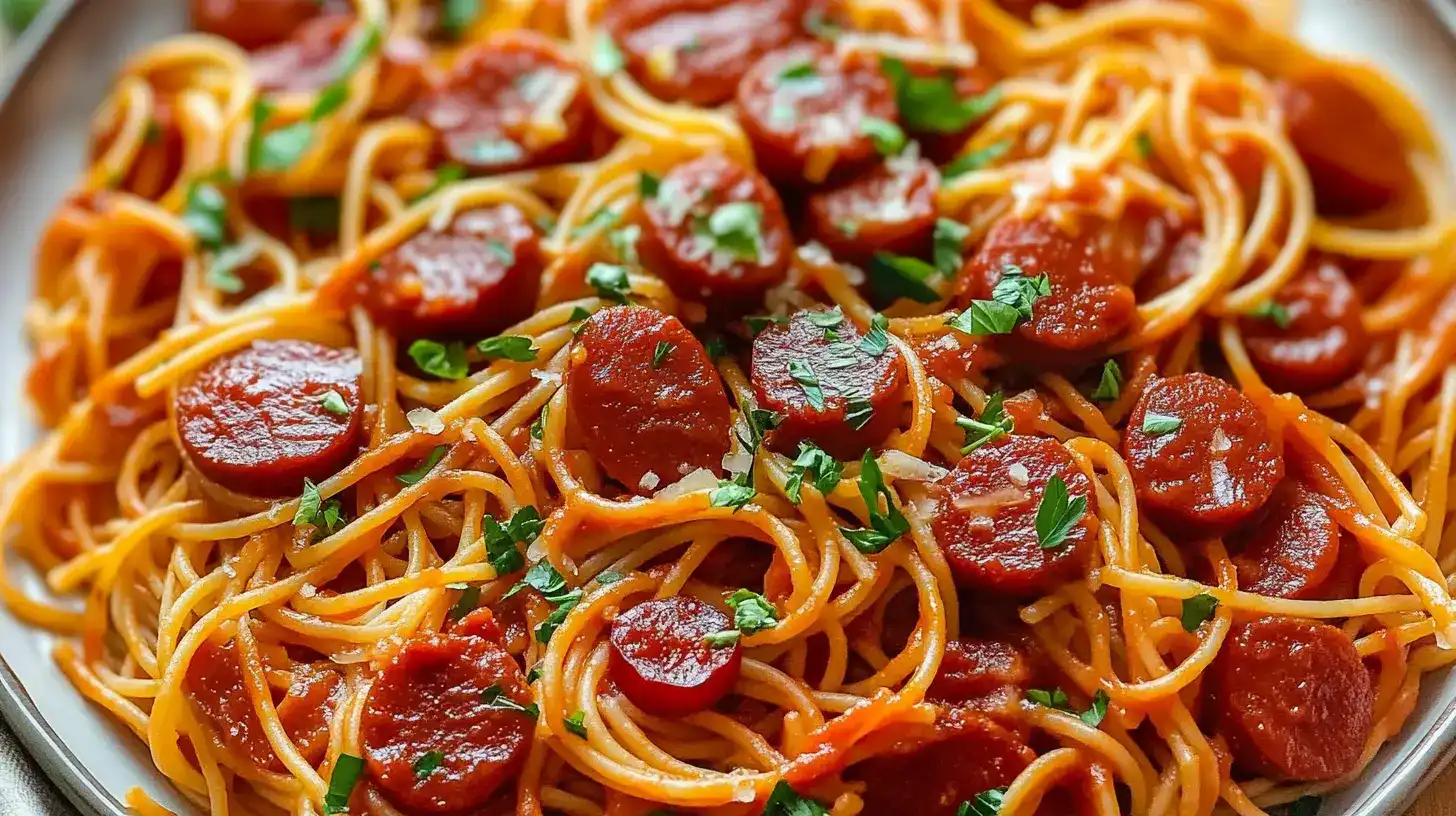Make a traditional Haitian pasta dish bursting with savory spices, vibrant aromatics, and comforting flavors.
Introduction
Haitian cuisine stands out for its savory, layered flavors. This haitian spaghetti recipe showcases a blend of herbs, peppers, and seasoned proteins. It’s a popular choice for breakfast, but also suits lunch or dinner. This guide covers its origins, ingredients, preparation steps, and serving ideas. By following these instructions, you’ll enjoy a comforting Haitian dish that connects you to Caribbean culinary traditions.
The Roots of Haitian Cuisine and the Haitian Spaghetti Recipe
Haitian cooking evolved from a rich tapestry of African, French, and Creole influences. Accordingly, many Haitian foods embody cultural resilience and adaptability. The haitian spaghetti recipe highlights this fusion. It’s often served as a morning meal, enjoyed with coffee, bringing families together around the table. Comparatively, this dish requires simple ingredients yet delivers complex flavor, reflecting Haitian cooks’ ingenuity through generations.
Initially influenced by indigenous Taíno techniques, Haitian cuisine later integrated African and European elements. Consequently, people learned to maximize limited resources, transforming everyday items into memorable meals. This adaptability is evident in Haitian pasta dishes, like the one we focus on here, which fuse familiar spaghetti with seasonings unique to Haiti.
Understanding the Significance of This Traditional Dish
In Haitian homes, spaghetti plays a role beyond a simple meal. Indeed, the dish warms hearts by recalling family gatherings and weekend breakfasts. While spaghetti is often seen as an Italian staple, Haitians embraced it, customizing it to local tastes. As a result, this Caribbean interpretation feels distinct and comforting. Its versatility allows it to be a quick lunch or a leisurely brunch plate.
Moreover, the haitian spaghetti recipe symbolizes how outside influences blend seamlessly with local flair. The final product is neither purely European nor entirely indigenous. Instead, it stands as a testament to Haitian culinary identity, cherished across generations.
Benefits of Making This Popular Haitian Dish at Home
- Affordability: Ingredients are basic pantry staples, keeping costs low.
- Versatility: You can adjust the protein and spice level as desired.
- Simplicity: Straightforward steps make this meal accessible to cooks of all skill levels.
- Cultural Connection: Preparing this Haitian pasta at home lets you experience authentic Caribbean flavors.
Elements Defining an Authentic Haitian Spaghetti Recipe
- Aromatic Vegetables: Onions, scallions, bell peppers, and garlic set the stage.
- Tomato Paste: Adds color, depth, and subtle sweetness.
- Fresh Herbs and Spices: Thyme, parsley, and Haitian seasoning blends lend signature character.
- Choice of Protein: Traditionally hot dogs, smoked herring, or sardines deliver savory richness.
- Moderate Heat: A hint of Scotch bonnet pepper offers gentle warmth, though optional.
Ingredients Needed for the Classic Haitian Spaghetti Recipe
H2: Key Components to Perfect Your Haitian Spaghetti Recipe
When making this dish, focus on quality, fresh items. Each ingredient contributes to a well-rounded flavor profile:
- Spaghetti: Regular durum wheat noodles hold up well.
- Onions, Bell Peppers, Garlic: Foundational aromatics for fragrance and flavor.
- Tomato Paste: Intensifies umami and provides a vibrant hue.
- Herbs (Thyme, Parsley) & Haitian Epis: Elevate the taste and add authenticity.
- Protein (Hot Dogs or Smoked Herring): Introduces a savory dimension.
- Oil, Salt, Pepper: Basics for sautéing and seasoning.
- Scotch Bonnet (Optional): Adds subtle heat and complexity.
H2: Selecting Fresh, High-Quality Ingredients
Choosing the best produce and proteins boosts overall taste. Fresh onions and peppers create a fragrant base. Meanwhile, quality hot dogs (or smoked fish) ensure robust flavor. Consequently, your haitian spaghetti recipe turns into a memorable meal rather than a simple pasta dish.
For a vegetarian version, simply omit meat. Instead, add mushrooms or other veggies. Haitian cooks often adapt dishes based on available ingredients, so feel free to personalize while preserving the core Caribbean essence.
H2: Step-by-Step Cooking Methods for a Perfect Haitian Spaghetti Recipe
Cooking the Spaghetti:
Initially, boil salted water and cook the pasta until al dente. Drain and set aside. Do not overcook, because you want the noodles to remain firm enough to soak up flavors.
Building the Sauce:
Heat oil, then sauté onions, bell peppers, and garlic until aromatic. Add tomato paste and stir until it deepens in color. Next, include chosen protein and herbs. Add salt, pepper, and a hint of spicy pepper if you like heat. The resulting mixture should become thick, flavorful, and inviting.
Combining Pasta and Sauce:
Return the drained spaghetti to the pan. Stir gently so each strand absorbs the savory sauce. Let it simmer briefly. Taste and adjust seasoning. The result: a harmonious plate that pays homage to Haitian flavor traditions.
Detailed Instructions from Start to Finish
H3: Choosing the Right Pasta for Your Caribbean Pasta Dish
Thick, good-quality spaghetti works best. It retains texture and ensures every forkful carries the sauce’s essence. Avoid delicate noodles that might turn mushy. This Haitian-style preparation benefits from a pasta that remains toothsome after cooking.
H3: Mastering Seasoning Techniques in This Caribbean Meal
Seasoning matters. Begin with Haitian epis, a flavorful herb-and-garlic blend that underpins many Haitian recipes. Sprinkle thyme leaves, parsley, salt, and pepper gradually. Taste as you cook. Adjust salt slowly, because balancing flavors is key. If using Scotch bonnet, start small. Add more if you crave extra heat. These steps ensure your haitian spaghetti recipe achieves the right harmony.
H3: Serving Suggestions for Your Haitian Spaghetti Recipe
Present the dish in shallow bowls. Garnish with fresh herbs for brightness. Offer lime wedges on the side. This dish pairs beautifully with Haitian coffee for breakfast. For lunch or dinner, try it alongside crisp plantains, a simple salad, or even Haitian pikliz (a spicy, pickled condiment) to cut through the richness. Serve warm and enjoy how all the flavors meld beautifully on the palate.
Tips and Tricks to Elevate This Haitian Pasta Dish
- Monitor Cooking Time: Stop boiling the spaghetti early enough to avoid a soggy texture.
- Balance the Heat: If using a hot pepper, add it gradually. A small piece can bring depth without overwhelming the dish.
- Use Fresh Herbs: They bring bright, authentic flavors that dried alternatives may not deliver.
- Adjust to Your Taste: Taste frequently. Add more salt or herbs if needed. This personalization makes the dish truly yours.
- Experiment with Protein: While hot dogs are common, smoked herring provides a more traditional Haitian touch.
Variations to Explore Beyond the Classic Approach
- Vegetarian Option: Skip meat. Add mushrooms, spinach, or carrots.
- Smoked Herring Variation: Replace hot dogs with smoked herring for a more traditional taste.
- Corned Beef Twist: Use canned corned beef in place of other proteins. It results in a richer, heartier meal.
- Extra Spicy: Add more Scotch bonnet or a pinch of cayenne for those who love heat.
- Whole-Grain Pasta: For a health-conscious spin, use whole-grain noodles and reduce oil.
Presentation and Pairings
Presentation enhances the dining experience. Garnish with a sprinkle of fresh parsley or thyme leaves for visual appeal. Serve with avocado slices or fried plantains for contrasting textures and flavors. Consider a side of pikliz for a vinegary kick. For beverages, Haitian coffee pairs well if served in the morning, while a crisp beer or ginger-infused lemonade is perfect for midday meals.
Cultural Importance of This Haitian Staple
Haitian dishes embody resilience, resourcefulness, and cultural pride. This Caribbean pasta meal, though simple, reminds many of Sunday mornings, shared stories, and family bonds. Despite external influences, Haitians made spaghetti their own, creating a comforting signature plate that stands apart from its European counterparts.
Over time, this Haitian take on spaghetti has spread beyond local borders. Food lovers worldwide appreciate its unique combination of seasonings. As a result, this dish becomes more than just a meal; it’s a culinary bridge connecting Haiti to the global food community.
Common Mistakes to Avoid
- Over-Salting Early: Because flavors intensify during cooking, add salt sparingly at first. You can always add more.
- Overcooking Pasta: Al dente noodles create the best texture. If they become mushy, the dish loses its character.
- Skipping Fresh Herbs: They’re crucial for authenticity and brightness.
- Ignoring Heat Levels: Be cautious with Scotch bonnet peppers. A small amount can transform the flavor.
- Using Bland Protein: Quality protein contributes deeply to the final taste. Choose flavorful hot dogs or well-prepared smoked herring.
Storage and Reheating
Store leftovers in an airtight container in the refrigerator for up to three days. When reheating, add a splash of oil or water to revive the sauce. Heat gently on the stovetop or microwave. Garnish with a few fresh herbs after reheating to restore brightness. Over time, the flavors meld even more, making leftovers especially comforting.
Nutritional Considerations
This Haitian-inspired pasta offers carbohydrates, protein, and some vitamins from peppers and herbs. For lighter options, choose whole-grain spaghetti and less oil. Add more vegetables for extra fiber and nutrients. Adjusting ingredients helps you tailor the dish to different dietary needs without losing its essential Caribbean charm.
Frequently Asked Questions (FAQ)
What is Haitian spaghetti made of?
This Haitian pasta dish typically features spaghetti noodles mixed with onions, bell peppers, garlic, tomato paste, and herbs. Traditionally, it includes proteins like hot dogs or smoked herring. The result is a deeply savory, aromatic plate distinct from standard pasta meals.
What is the main dish of Haitian food?
Haitian cuisine offers many iconic meals. Rice and beans (diri ak pwa) form a cornerstone, while dishes like griot (fried pork) and tasso (dried spiced beef) are also popular. Haitian spaghetti, though not always the “main” dish, frequently appears in everyday Haitian life.
What ingredients does spaghetti contain?
Standard spaghetti is made from wheat flour and water. On its own, it’s a blank canvas. In this Haitian preparation, the noodles become a flavor-packed foundation. Vegetables, herbs, and proteins transform plain strands into a vibrant, comforting meal reflective of Haitian culinary heritage.

